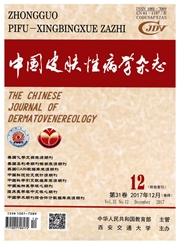

 中文摘要:
中文摘要:
目的探讨全反式维A酸(at—RA)抑制光老化皮肤基质金属蛋白酶(MMP)-3和MMP-13表达的受体机制。方法中长波紫外线照射ICR小鼠12周,建立皮肤光老化动物模型,按照实验分组进行at—RA、维A酸受体(RAR)/维A酸X受体(RXR)的激动剂/拮抗剂干预后,HE染色观察皮肤组织病理学的改变;Western blot检测MMP-3和MMP-13的蛋白表达水平;碱水解法检测皮肤胶原蛋白的含量。结果与模型对照组相比,at—RA组、RAR激动剂组胶原蛋白含量增多,MMP-3和MMP-13表达量明显减少(P均〈0.01),而RXR激动剂组与模型对照组的差异无统计学意义;at—RA/RAR激动剂+RAR拮抗剂组较at—RA/RAR激动剂组胶原蛋白含量减少,MMP-3和MMP-13表达量显著增多(P均〈0.01),而at—RA+RXR拮抗剂组与at—RA组的差异无统计学意义。结论at—RA可通过RAR下调MMP-3和MMP-13蛋白的表达,抑制光老化皮肤胶原的降解。
 英文摘要:
英文摘要:
Objective To investigate the receptor mechanisms of all-trans retinoic acid (at-RA)-induced inhibition of matrix metalloproteinase (MMP)-3 and MMP-13 in photoaged skin. Methods The photoaged model was established by irradiation of ICR mice with UVA and UVB for 12 weeks. The photoaged mice were treated topically with at-RA, retinoic acid receptor (RAR) or retinoid X receptor (RXR) agonist/antagonist. HE staining was used to evaluate the histopathologic changes in the skin while expression levels of MMP-3 and MMP-13 protein were analyzed by Western blot. The collagen contents were measured by the method of alka- line hydrolysis. Results Compared with vehicle controls, the collagen contents were increased in mice treated with either at-RA or RAR agonist, while the expression levels of MMP-3 and MMP-13 were reduced significantly ( all P 〈 0. 01 ). In contrast, the expression levels of MMP-3 and MMP-13 were no significant differences between RXR agonist and vehicle controls. The collagen content was lower in mice treated with at-RA/RAR agonist plus RAR antagonist group than at-RA/RAR agonist treatment, whereas the expression levels of MMP-3 and MMP-13 were significantly higher in at-RA/RAR agonist plus RAR antagonist group than at-RA/RAR agonist treatment (all P 〈 0. 01 ). However, the expression levels of MMP-3 and MMP- 13 were no significant differences between at-RA plus RXR antagonist group and at-RA group. Conclusion At-RA inhibits the degradation of collagen via RAR to downregulate the expressions of MMP-3 and MMP-13 in photoaged skin.
 同期刊论文项目
同期刊论文项目
 同项目期刊论文
同项目期刊论文
 期刊信息
期刊信息
